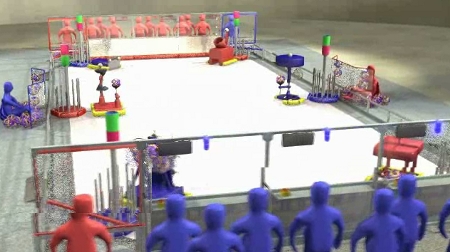High-school students catch robotics Lunacy
Last updated Jan 3, 2009 — 693 views Game strategy and rules for the 2009 FIRST high-school robotics competition were unveiled today in Manchester, NH. Some 42,000 high-school students on 1,686 teams from a dozen countries will participate in this year’s contest, which is designed to simulate robotic rovers moving on a lunar crater.
Game strategy and rules for the 2009 FIRST high-school robotics competition were unveiled today in Manchester, NH. Some 42,000 high-school students on 1,686 teams from a dozen countries will participate in this year’s contest, which is designed to simulate robotic rovers moving on a lunar crater.
The game, known as “Lunacy,” consists of a series of 135-second face-offs on a 27 x 54 foot game field dubbed “the crater.” To gain points, the student-designed robots must pick up 9-inch game balls and deposit them in trailers hitched to the opposing teams’ robots. Additional points are scored by placing a special game ball — the “super cell” — in the opponents’ trailers during the final 20 seconds of each match.
Among other unique challenges in this year’s contest, the crater is coated with regolith, a slick polymer material, and special wheels are used to create a low-traction interaction with the crater’s surface. Together, these combine to simulate the one-sixth gravity on the surface of the moon and require the students to “contend with the laws of physics,” says FIRST.
The following three-minute animation shows a simulated Lunacy match, and explains the overall strategy and rules:
FIRST Robotics “Lunacy” competition 2009 animation
(Click image to play video)
As part of today’s kickoff event, the students were shown Lunacy’s regulation game field. Each team also received a standard kit of parts comprised of motors, batteries, a micro-computerized control system, and various automation components. No instructions for building the robots were included in the kits, however — that task falls on the individual teams along with their adult mentors.
The teams now have six weeks to design, build, program, and test their robots. After that, they’ll participate in regional competitions that will help them wring out their robots’ bugs and design flaws. There will be 40 regional events in the U.S., Canada, and Israel, plus seven district competitions and one state championship in Michigan, leading up to the 2009 FIRST Championship at the Georgia Dome in Atlanta, April 16-18.
This year’s event marks FIRST’s (For Inspiration and Recognition of Science and Technology) 18th season. The annual competition aims to “help students discover the rewards and excitement of science, engineering, and technology.” FIRST’s “Founding Sponsors” include Boston Scientific, Baxter, the Chrysler Foundation, DEKA Research & Development, Delphi, General Motors, Johnson & Johnson, Kleiner Perkins Caufield & Byers, Motorola, and Xerox. FIRST’s “Strategic Partners” include BAE Systems, Boeing, FedEx, General Motors, Johnson & Johnson, NASA, National Instruments, Rockwell Automation, and Rockwell Collins.
For more info about FIRST’s student robotics projects and competitions, visit the US FIRST website.



